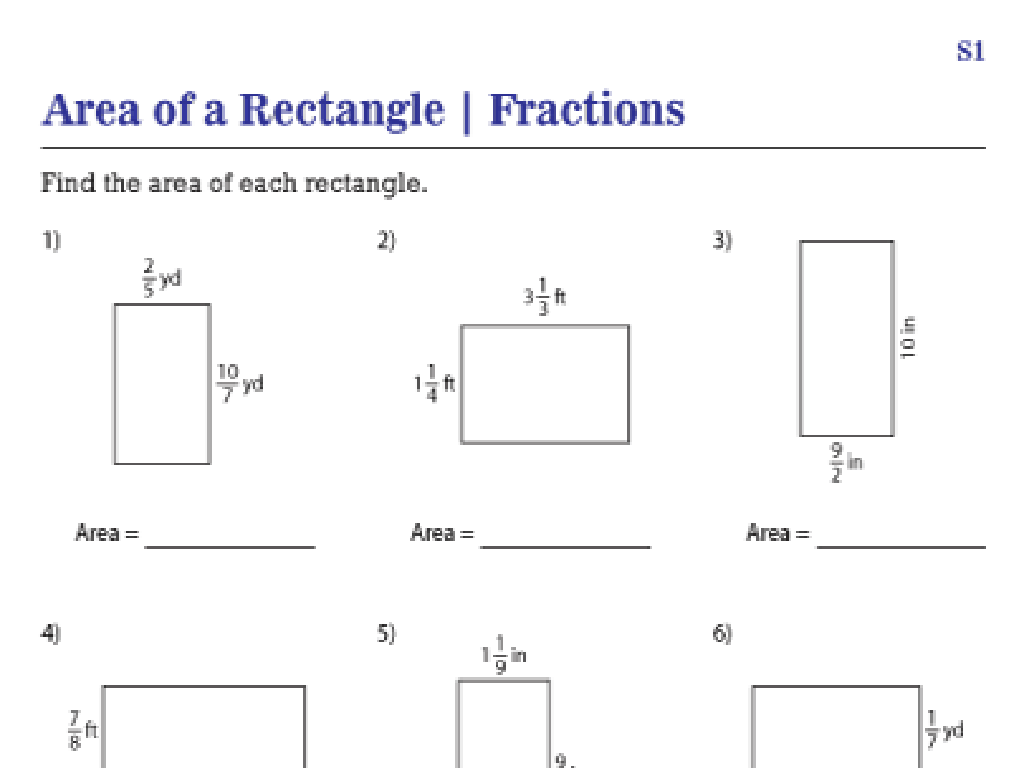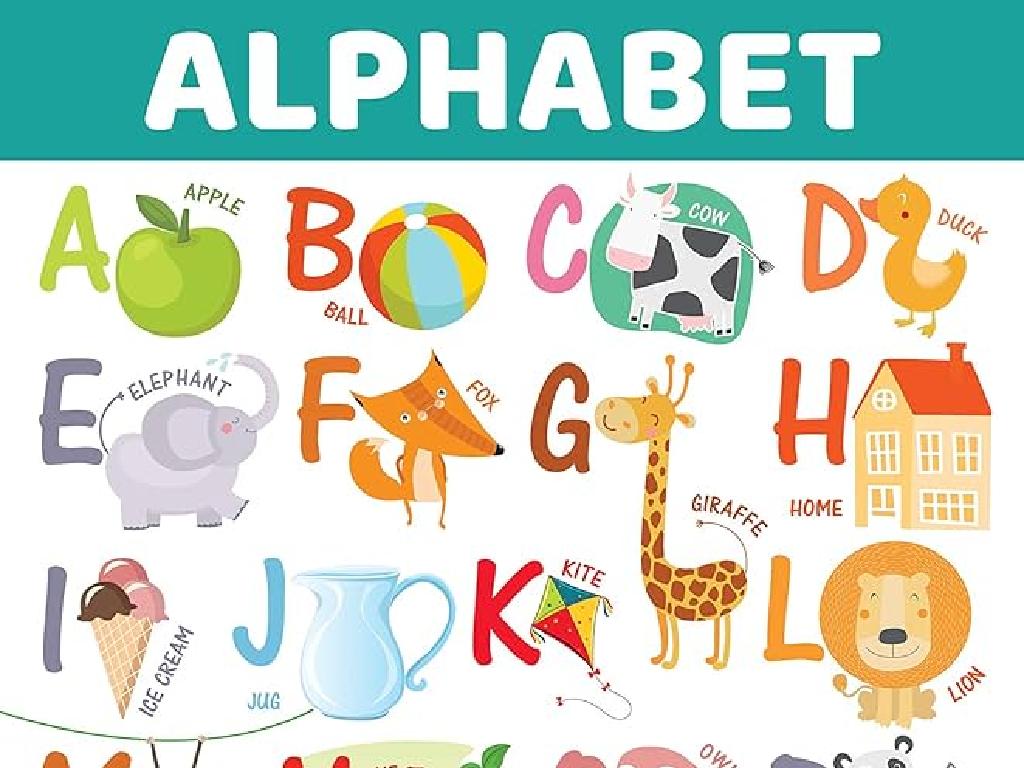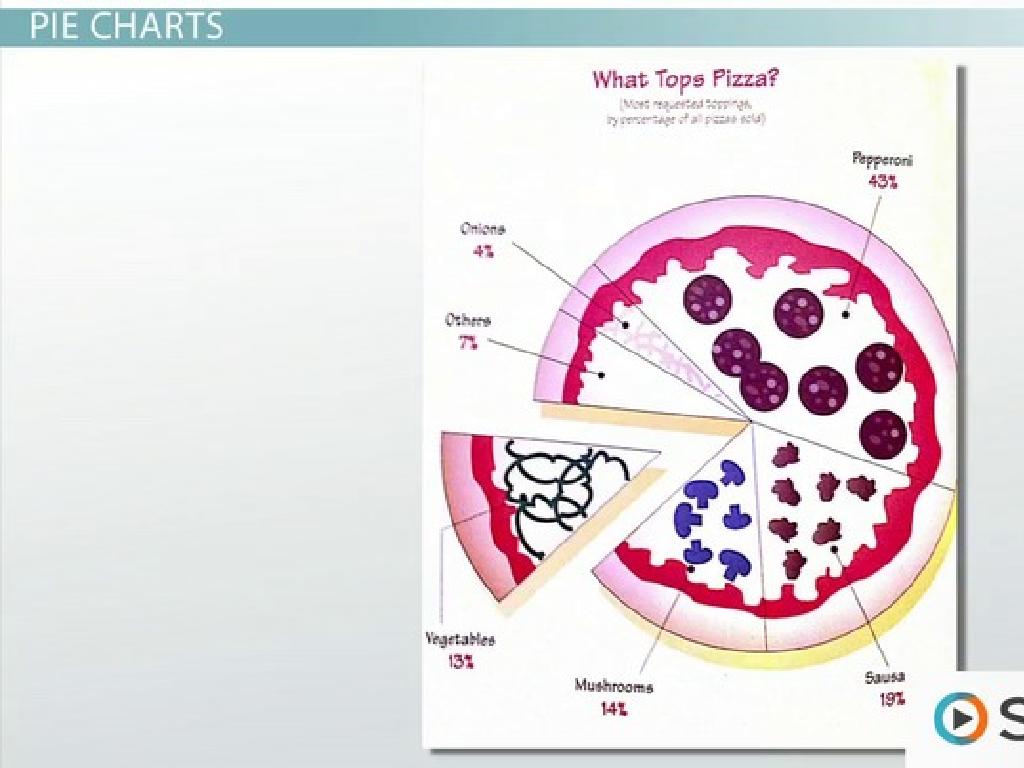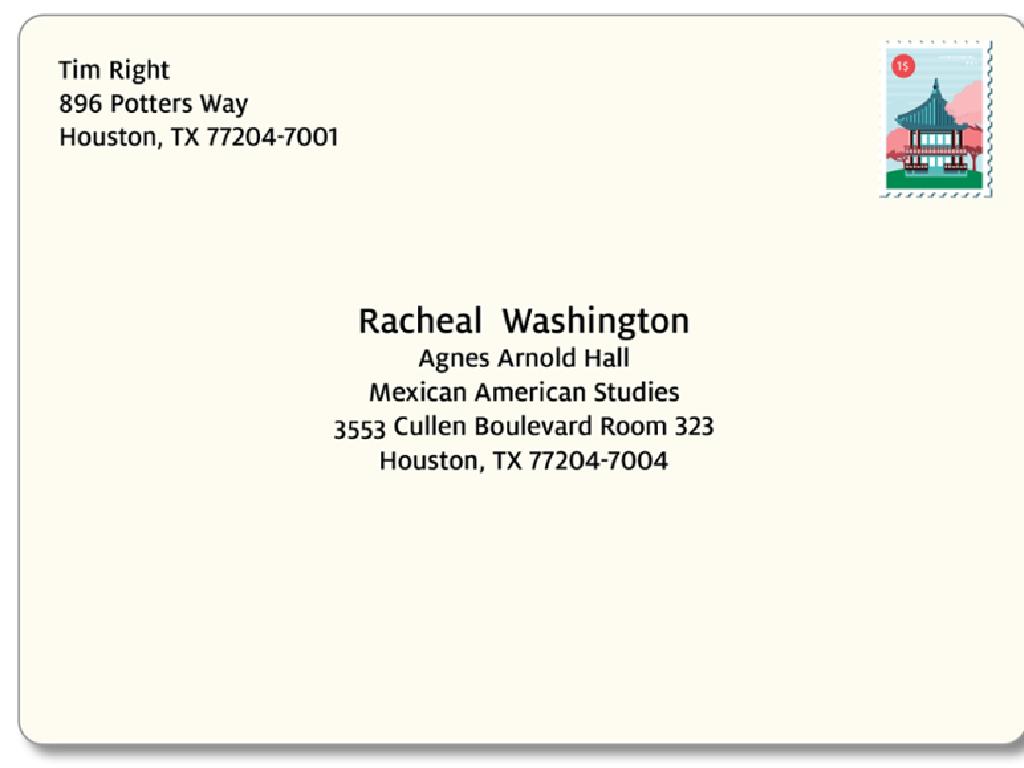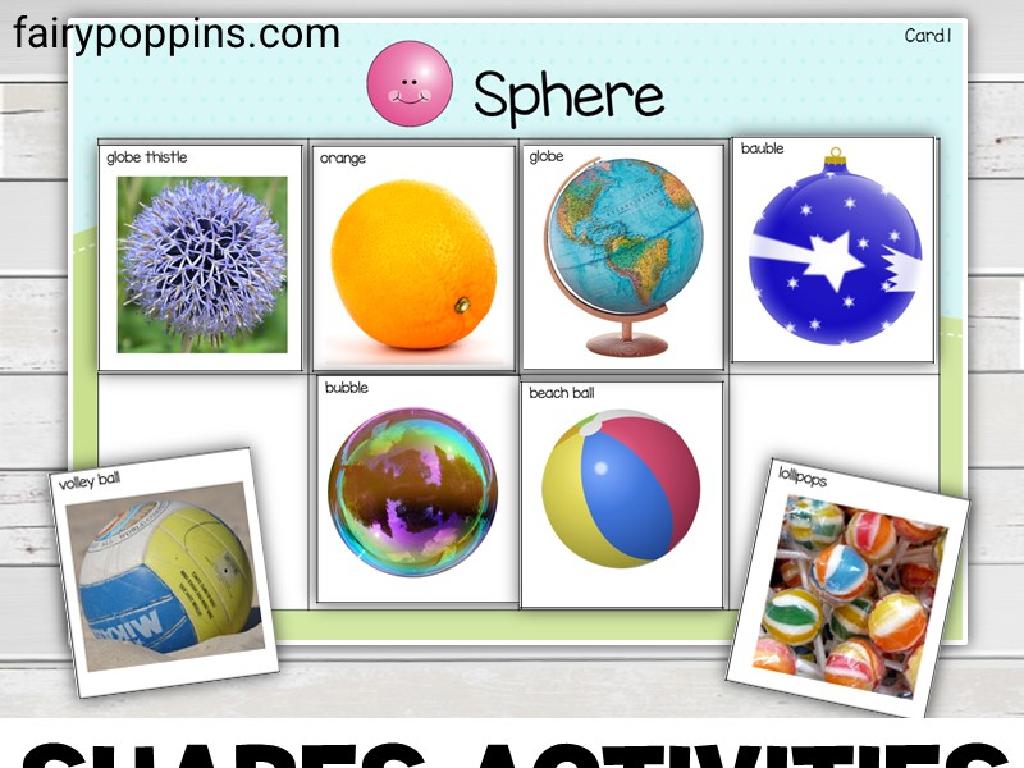Choose Customary Units Of Mass
Subject: Science
Grade: Fourth grade
Topic: Units And Measurement
Please LOG IN to download the presentation. Access is available to registered users only.
View More Content
Today’s Adventure: Choosing Customary Units of Mass
– Why do we measure mass?
– Explore ounces, pounds, and tons
– Smallest unit is ounce, larger unit is pound, and the largest is ton
– When to use each unit?
– Use ounces for light items, pounds for heavier, tons for very heavy objects
– Real-world examples
– Ounces: a pencil, Pounds: a dog, Tons: a car
|
This slide introduces students to the concept of measuring mass and the customary units used in the United States. Start by discussing the importance of measurement in everyday life and science. Introduce ounces, pounds, and tons as units of mass, and explain that the choice of unit depends on the weight of the object being measured. Provide relatable examples for each unit to help students grasp the concept of scale. For instance, a pencil can be measured in ounces, a dog might be measured in pounds, and a car is best measured in tons. Encourage students to think of other examples and to understand that choosing the appropriate unit is crucial for accurate measurement.
Understanding Mass in Science
– Mass versus Weight
– Mass is how much matter is in something; weight is the force of gravity on it.
– Mass: Matter in an object
– Think of mass as the amount of ‘stuff’ in your toys or books.
– Measuring mass tells object’s heaviness
– We use scales to see how heavy something is without gravity s effect.
– Tools to measure mass
– Balances and scales help us measure mass accurately.
|
This slide introduces the concept of mass and how it differs from weight, which is a common point of confusion. Mass is a measure of how much matter an object contains, while weight is the force exerted by gravity on that mass. Emphasize that mass remains constant regardless of location, whereas weight can change if the force of gravity changes. Use relatable examples like the mass of their school backpack or a pile of books to illustrate the concept. Explain that scientists use tools like balances and scales to measure mass, and these tools are crucial for various scientific and everyday tasks. Encourage students to think about why knowing the mass of an object might be important in real life, such as for cooking or mailing packages.
Customary Units of Mass
– Understanding ounces (oz)
– Smallest unit, e.g., a pencil or a slice of bread
– Learning about pounds (lb)
– Heavier items, e.g., a dog or a bicycle
– When to use tons (T)
– Very heavy objects, e.g., cars or elephants
– Choosing the right unit
– Consider the object’s weight and compare with examples
|
This slide introduces students to the customary units of mass commonly used in the United States: ounces, pounds, and tons. Start by explaining that ounces are used for very light objects, such as a pencil or a slice of bread. Pounds are for heavier items that they can hold in their hands, like a pet dog or a bicycle. Tons are for things that are much heavier, such as cars or elephants. To help students choose the appropriate unit, provide them with relatable examples and guide them to think about the weight of an object in comparison to these examples. Encourage them to ask themselves, ‘Is this item as heavy as something I know?’ This will help them decide which unit is most suitable for measuring the mass of different objects.
Understanding Mass: Using Ounces
– When to use ounces?
– Use ounces for small, light objects.
– Examples: bread and pencil
– A slice of bread or a pencil can be measured in ounces.
– Estimate classroom items in ounces
– Guess the weight of items like erasers or paperclips.
– Practice with real objects
|
This slide introduces students to the concept of measuring mass using ounces, which is suitable for small and lightweight objects. Start by explaining that ounces are a smaller unit of mass, often used to measure items that are not very heavy. Provide everyday examples, such as a slice of bread or a pencil, to make the concept relatable. Then, engage the students in a hands-on activity where they estimate the mass of various classroom items in ounces, such as erasers, paperclips, or small books. This practical exercise will help them develop a sense of what an ounce feels like and how to use this unit of measurement in real-life situations. Encourage students to bring items from home that they think would be measured in ounces for further practice.
Understanding Mass: Using Pounds
– When do we use pounds?
– Pounds measure the weight of objects that are not too heavy or light.
– Examples: textbook, small dog
– A textbook might weigh about 5 pounds, a small dog could be around 10 pounds.
– Activity: Heavier or Lighter?
– Compare different classroom items to learn which are heavier or lighter.
|
This slide introduces the concept of measuring mass using pounds, a customary unit of mass. Explain that pounds are used for objects that are not too heavy or too light, such as a textbook or a small dog. For the activity, students will select various items around the classroom and use their judgment or a scale to compare their weights, determining which items are heavier or lighter. This hands-on activity will help solidify their understanding of the practical use of pounds as a measurement. Encourage students to guess before measuring and discuss why some items might be heavier or lighter than they appear.
Understanding Mass: When to Use Tons
– Tons for measuring heavy items
– Examples: cars and elephants
– Cars and elephants are very heavy, so we use tons to measure them.
– Discuss: Why not ounces for a car?
– Ounces are too small to measure something as big as a car efficiently.
– Understanding the scale of mass
|
This slide is aimed at helping students understand the concept of mass and when to appropriately use the unit of ‘tons’. Tons are a large unit of mass, best suited for measuring very heavy objects, such as cars and elephants. The discussion point about why we don’t use ounces for a car will help students grasp the impracticality of using a small unit to measure a large mass, emphasizing the importance of choosing an appropriate scale. It’s a good opportunity to introduce the concept of scale and how different units of measurement are used for different sizes of mass. Encourage students to think of other heavy items that would be measured in tons and to consider the inconvenience of using a smaller unit like ounces for such large masses.
Converting Customary Units of Mass
– Ounces in a pound
– There are 16 ounces in one pound.
– Pounds in a ton
– 2000 pounds make one ton.
– Let’s practice conversions
– We’ll convert units together as a class activity.
– Conversion tips and tricks
– Use multiplication and division for unit conversions.
|
This slide introduces students to the concept of converting between different customary units of mass. Start by explaining that there are 16 ounces in one pound, which is a standard measurement in the United States. Then, discuss how many pounds are in a ton, emphasizing the large number (2000) to show the difference in scale. Engage the class with practice conversions to reinforce learning, using real-world examples like the weight of their textbooks or a bag of apples. Provide tips for remembering conversion factors, such as visual aids or mnemonic devices. The goal is to make students comfortable with the idea of converting units and to understand the practical applications of these skills.
Real-life Application: Choosing the Right Unit of Mass
– Importance of correct mass unit
– Ensures accuracy in cooking, medicine, and more
– Mass in recipes & shopping
– Use ounces or pounds for ingredients and food
– Estimating mass in daily life
– Guess the weight of objects before using a scale
– Measuring mass accurately
– Use scales for precise measurements in activities
|
Understanding the importance of choosing the correct unit of mass is crucial for accuracy in various aspects of daily life, such as cooking, where a recipe’s success depends on precise measurements, or in medicine, where dosages must be exact. When grocery shopping, we use ounces or pounds to buy the right amount of food. Estimating mass can be a fun activity, where students guess the weight of objects before actually measuring them, enhancing their ability to judge and compare masses. Measuring mass accurately with scales is an essential skill, whether in science experiments or in the kitchen. Encourage students to practice these skills at home and share their experiences in class.
Class Activity: Mass Scavenger Hunt
– Find classroom items for mass categories
– Work in groups: ounces, pounds, tons
– List items under correct mass unit
– Share and discuss findings with class
|
This interactive activity is designed to help students understand and apply their knowledge of customary units of mass. Divide the class into small groups and assign each group to find items in the classroom that could be measured in ounces, pounds, or tons. Provide them with a chart to categorize their items. After the scavenger hunt, each group will present their findings, discussing why they chose each unit of mass for the items. Possible items could include a paperclip (ounces), a textbook (pounds), or the classroom desk (tons, as a conceptual example). Encourage students to think critically about the most appropriate unit of mass for each item and to be ready to explain their reasoning during the discussion.
Conclusion: Customary Units of Mass
– Recap customary units of mass
– Ounces (oz), pounds (lb), and tons
– Importance of the right unit
– Correct unit makes measurements meaningful
– Engage in a Q&A session
– Ask questions to clear up any confusion
– Review key takeaways
|
As we wrap up, let’s review the customary units of mass such as ounces, pounds, and tons. Understanding when to use each unit is crucial for accurate and meaningful measurements in real-life situations. Encourage students to ask questions during the Q&A session to address any uncertainties they may have. This will ensure they have a solid grasp of the concepts before moving on. Use examples like comparing the weight of a feather (in ounces) to the weight of a car (in tons) to illustrate the importance of choosing the appropriate unit for different scenarios.

